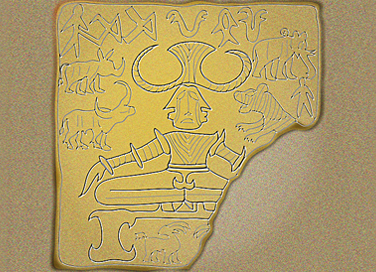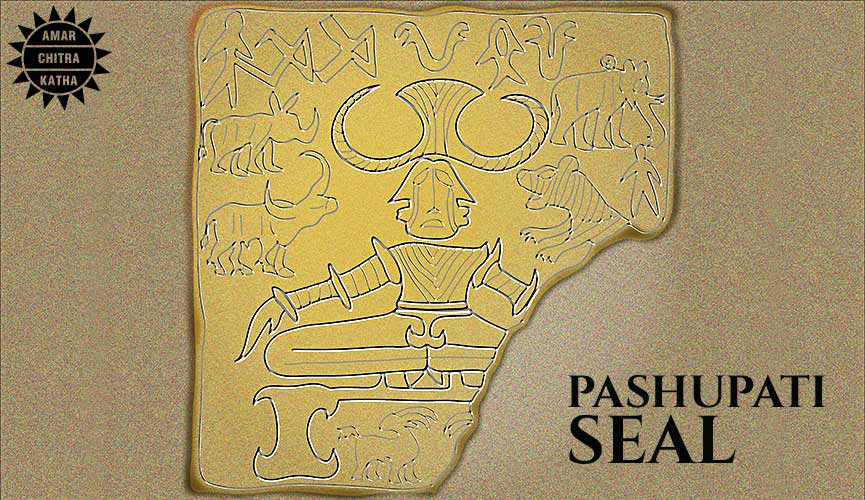The Pashupati Seal of Mohenjo-Daro
- January 18, 2021


The Pashupati Seal of Mohenjo-Daro
- January 18, 2021
By Shivam Pathania

The Indus Valley civilization is an enigma. Since its discovery, many historians have been trying to study the life of the ancient cities’ dwellers through the historic monuments and the ancient relics. The Pashupati seal, found during the excavation of the ancient city of Mohenjo-Daro in Indus valley is one such relic, with many different and contradicting interpretations by different historians that shed a light on the religious practices of the civilization. The small relic is a big piece to solve the ancient puzzle, that is Indus Valley civilization.
The tiny seal measures 3.56 cm by 3.53 cm, with a thickness of 0.76 cm and is made out of soapstone or steatite. The seal was uncovered in 1928-1929 and is considered to be made during 2350-2000 BCE. The prominent figure in the seal is the man with the horned headdress, which is unusual as most Indus Valley seals show animals as the central figure in their seals instead of a human being. The man is seated on a raised platform in a yogic position and he is depicted to have three long faces with pointed noses. His arms are adorned with numerous bangles, from his wrist and all the way to his shoulder and his entire torso is covered in necklaces. He also has a belt decorated with tassels at his waistline. The seal depicts various wild animals around the seated figure, most of which are herbivores. A rhinoceros, an elephant, a buffalo and a tiger are shown in the seal, where the tiger seems to be pouncing on the seated man. Two goats also can be seen right in front of the seated figure, but it seems to be unclear whether the goats are actual animals or a design aspect of the raised platform. The seal is also inscribed with the Indus Valley civilization script, which has still not been deciphered. The exact functional purpose of the seal is still unknown, but according to some experts, such seals were used during the trade. But many seals also have a hole behind them suggesting that such seals were also worn as amulets. Therefore, the seal could have been an identification seal of a community in the settlement or was worn as a symbol of status.
To receive more such stories in your Inbox & WhatsApp, Please share your Email and Mobile number.
Many interpretations have been made by historians to decode the intended narrative of the scene depicted in the small seal. According to the most common and most widely accepted interpretation, the seated human figure is Shiva or his Vedic alias Rudra. Archaeologist John Marshall, the Director-General of the Archaeological Survey of India, first came up with this interpretation due to four reasons. In some forms Shiva is depicted with four or five heads, which appear to be three, when seen from the front view, matching with the number of faces of the seated figure. Further, the horns on the headpiece can be associated with the bull, Nandi, Shiva’s vahana. Also, the yogic posture of the seated man, ties him closely to Shiva, as Shiva is known as Adiyogi or the first yogi and the originator of yoga. The seated man is surrounded with wild animals, which can be associated with another form of Shiva called as Pashupati, which translates as ‘the king of all animals’. Hence, the name, Pashupati was given to the seal.
The theory was widely accepted, but it was met with objections too, with some historians reinterpreting the seal differently. Doris Srinivasan, a professor of Indian studies, said that the human figure in the seal was rather a deity who was half-buffalo and half-man. According to her studies, the seated figure had cow-like ears instead of three faces. Since the Indus valley civilization was an agrarian society, cattle were crucial assets for them. Male cattle helped with ploughing and carrying a load, while their female counterparts provided with dairy and thus having a deity dedicated to cattle made sense.
There is another interpretation with the same buffalo-man hybrid, but instead of being a deity, the seated entity is identified as an asura. Some scholars believe the horned entity to be the earliest pictorial depictions of Mahishasura, the asura, who was half-buffalo and half-man and the evil asura was defeated by Goddess Durga. Her vahana, Dawon, a tiger, is depicted attacking the horned asura in the seal. Many historians have also associated the seated figure in the seal to Vedic deities like Agni, Indra and Varun.
Apart from the religious interpretation of the seal, the yogic posture of the seated man helps to trace back the history of yoga in the Indian subcontinent. The yogi in the seal is seated in an advanced yogic position called Mulabandhasana which requires flexibility in the hips, knees, legs, ankles and feet. This level of difficult yoga was prevalent in the Indus Valley which suggests that yoga has been practised by the people in the civilisation from a long time and therefore, there is a possibility that yoga was established before or with the Indus Valley civilisation.
Read more about the Harrapan civilisation in our title ‘The Indus Valley Adventure’. Now available on the ACK Comics app, Kindle, Flipkart, Amazon, and other major e-tailers.
To receive more such stories in your Inbox & WhatsApp, Please share your Email and Mobile number.

Comic of The Month
The Naval Journey of India Book I
This book is the first of a three-book series that takes a deep and detailed look at India's Naval History and a deep insight into the lives of our men and women in white. But any series on the Indian Navy has to start at the very beginning - exploring India's celebrated maritime history. Join our little hero, Bharat, and his grandfather, Commodore Sagar, as they sail into the deep blue waters of time. Book I of The Naval Journey of India takes a sweeping look at India's maritime endeavours, how the seas impacted us over millennia and how the oceans made us who we are.